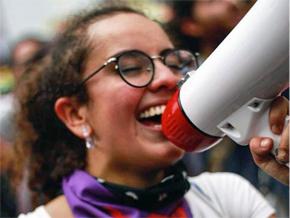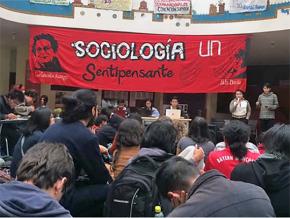Colombia students strike against education cuts
reports from Bogotá about the dynamic movement among higher education students in Colombia fighting for public education against the right’s cuts.
HIGHER EDUCATION students throughout Colombia have been taking part in a national strike to protest the defunding of public education.
The Paro Nacional de Estudiantes (national student strike) started earlier this month in response to numerous local and national laws and policies that have the cumulative goal of defunding public education.
Since 1992, public universities have not seen an increase in their budgets, despite increasing their enrollment by 130 percent. As a result, public universities have turned to private funding as a stopgap. While in 1992, a public university could expect to receive 100 percent of its funding through state spending, that number is closer to 50 percent today.
This is causing immense budgetary stress on public institutions, with some universities on the verge of bankruptcy. Experts, including the president of the university, have said that the National University does not have enough funding to make it through the year. All signs indicate that this crisis will worsen unless immediate action is taken to fund public education.

In all, 45 institutions have joined the strike — 33 universities and 12 other institutions of higher education. While the strike has taken many forms, classes at La Universidad Nacional de Colombia sede Bogotá (UN sede Bogotá) have been replaced with spaces to speak about the movement and the current threat to public education and services in Colombia.
On October 17, students from UN sede Bogotá joined a march of over 15,000 through the streets of Colombia’s capital of Bogotá. The protest, which followed an even larger march the week before, started at multiple points and stopped traffic for miles in all directions.
The march ended in La Plaza de Bolívar, where the office of the president and the Palace of Justice are located. On one side of the square was an enormous stage with a banner from Asociación Sindical de Profesores Universitarios (ASPU), the public university professors union.
The strike has garnered support from several other major unions in Bogotá, including La Federación Colombia de Trabajadores de la Educación (Fecode), the public school teachers’ union, which announced at the rally that it would join the strike in support of public education funding.
THE STUDENTS have published a list of 10 demands, and many have declared that they will be on indefinite strike until a negotiation table is set up with the government. The demands are as follows:
1. A budgetary increase of 4.5 billion Colombian pesos to public Institutions of Higher Education (Instituciones de Educación Superior, or IES)
2. The resettlement of students’ debts with the Icetex, with a real interest rate at 0 percent, cancellation for students of the Ser Pilo Paga program, including those who have dropped out of the program, and guarantees of permanence and graduation to students who agreed to the program.
3. Immediate freezing of the increase in the value of enrollments in private Institutions of Higher Education.

4. A budget increase for Colciencias of 100 percent based on the budget assigned to Colciencias for 2018 and the change of measurement criteria and allocation of resources to the same institution.
5. Creation of a payment plan for the historic debt that the state has with public universities within the framework of the National Development Plan (today it is 18.2 billion Colombian pesos), and which must be paid within a period of no more than 10 years.
6. Maintain the resources of the National Apprenticeship Service (Servicio Nacional de Aprendizaje, or SENA).
7. Repeal of Law 1911 of Income Contingent Financing under the construction of a new fiscal rule.
8. End the mandate that Institutions of Higher Education perform high-quality accreditation processes of programs — this must be voluntary.
9. Repeal of Law 1740 and Decree 1280 because they curtail university autonomy.
10. Respect and guarantees for mobilization without retaliation in public and private Institutions of Higher Education.
It’s worth noting the deliberate use of the phrase “Institutions of Higher Education,” which reflects the fact that it isn’t only public universities that are under attack. Technical colleges and other institutions of higher education are seeing massive budget cuts as well. Many such institutions, like their university counterparts, are near bankruptcy.
Although there has been some maneuvering to win gains for public universities at the expense of these other institutions, the student movement has opted to show considerable solidarity, uniting around the idea that all public higher education should be fully funded.
AT UN sede Bogotá, budget cuts are nothing new, but the level of activity and organizing is breathing new life into a campus known for its militancy. As student Cristian Polo explains:
The university has gone through several phases. At first, it was a university of the elites. It was not very rebellious until the 1930s when the Communist Party began to have a lot of strength on campus.
For a long time, the university was a center of the popular classes and the very poor. But about 10 years ago, the composition of the university changed to serve more upper-middle-class students, due to reforms. This has led to a decrease in the strength of the student movement. The strike has served as a reminder of forgotten struggles.

This history can be felt in the way the campus is organized. The 10 demands were decided at two national assemblies — democratic spaces where interventions, proposals and decision-making take place — organized by the Encuentro Nacional de Estudiantes de Educación Superior (ENEES).
The first assembly was at UN sede Bogotá with around 2,000 students, and the second was in Florencia Caquetá at la Universidad de la Amazonia with over 3,000.
While ENEES coordinates the national movement, many other student groups are also playing a role, including La Asociación Colombia de Representantes Estudiantiles (ACRES), OCE (Organización Colombiana de estudiantes), ACEU (Asociación Colombiana de estudiantes universitarios), FEU (Federación de estudiantes universitarios), Modep (movimiento por la defensa de los derechos del pueblo), Identidad Estudiantil, Red Estudiantil Organizada and the anarchist Acción Libertaria Estudiantil.
This level of organization allows for a wide variety of organizing around specific issues. For example, feminists on campus have made an enormous impact on the larger movement in a very short period of time.
This was evident during the march, both from the large number of feminist chants being echoed far and wide, but also in signs throughout the march calling for “¡Educación pública, gratuita y antipatriacal!” (Education: Public, free of charge and anti-patriarchal!).
This slogan had been raised by a relatively small group of feminists just a week earlier. At the rally, many took it up in chants like this one:
Las mujeres la queremos
Pública, gratuita y antipatriacal
Las feministas la queremos
Pública, gratuita y antipatriacal
Las maestras la queremos
Pública, gratuita y antipatriacalWomen, we want it
Public, free of charge and anti-patriarchal
Feminists, we want it
Public, free of charge and anti-patriarchal
Teachers, we want it
Public, free of charge and anti-patriarchal
ON THE day before the October 17 march, I had the chance to go with a sociology student to three local assemblies. Each assembly included notetakers and moderators to facilitate the decision-making process among such a large number of people and produce a record to hold people accountable to those decisions.
The day started fairly early with our first assembly — this one of just sociology majors and attended by about 100 students. The next assembly, with about 300 students, was for all majors in the human sciences department.
On this particular day, the task at hand for the assemblies at the major, departmental and university levels was selecting representatives to join negotiations with universities around the country and express the demands of the student movement to the government.
The students discussed criteria for the selection of these representatives, as well as the functions that they would carry out. Some of the criteria that students established include participation in the strike and its organization, participation in democratic spaces such as the assemblies and a adherence to the decisions made in those assemblies.
This last criteria was particularly emphasized. “We’ve chosen to name the people who are going to represent us ‘vocerxs,’” said sociology student Isabel DeBorst (“vocerxs” can be loosely translated as “speaker”). “Their main role is to carry the collective voice of the assemblies, and to respect the decisions we make there. We’ve chosen these people because we trust they won’t sell out the student movement”.
After establishing the criteria for the selection and the functions that the vocerxs would carry out, majors, departments and then the general university assembly selected the people who would represent them at each level — all of whom are subject to recall if they don’t comply with the decisions of the assemblies. Every assembly was full of comradely, if lively, debate and discussion.
Not all universities organize themselves in this way, but there is a vibrant democratic impulse throughout the movement, which can be seen in the unity of national actions, and in the strength of the commitment to solidarity.
STUDENTS ARE drawing radical conclusions about who is to blame for the cuts in public education, and making connections to the state of broader public services. These students see budget cuts and freezes at their universities and technical colleges as part of a larger neoliberal agenda in Colombia that has been going on for decades.
Polo says that the current student movement places the blame squarely on capitalism:
All this is a consequence of neoliberalism. Universities have become trenches of resistance to capitalism. The popular movements are very clear: we are heirs of a resistance of 500 years against the cultural and economic impositions of the north. This is very present in social movements. Social movements are anti-capitalist and anti-imperialist. The student movement has been critical of the capitalist system and its consequences.
Juliana Vargas, another striking student, says, “Public universities are the only possibility for a large number of working class people to access a quality education. Quality private universities are simply not affordable. And that tells us a lot about the costs of privatization on people’s access to basic rights.”
As this article went to press, the new government of right-wing President Iván Duque Márquez was showing no sign of meeting the demands of the movement, and students at UN sede Bogotá were deciding whether or not to continue their strike.
Many universities have already declared that they will go on indefinite strike until negotiations are set up with the government.


